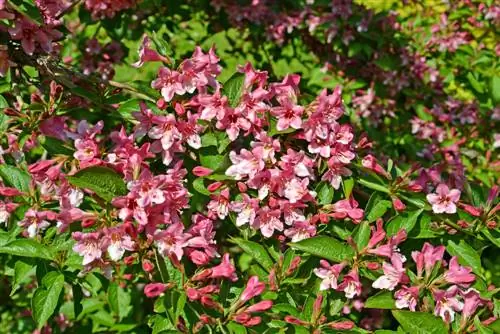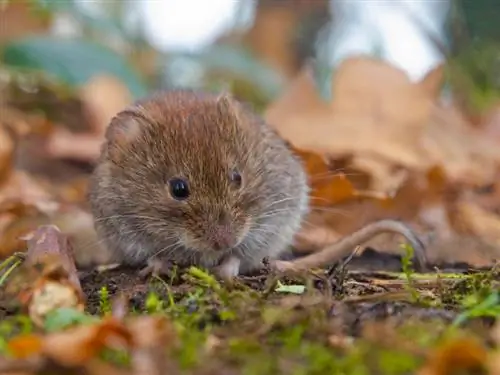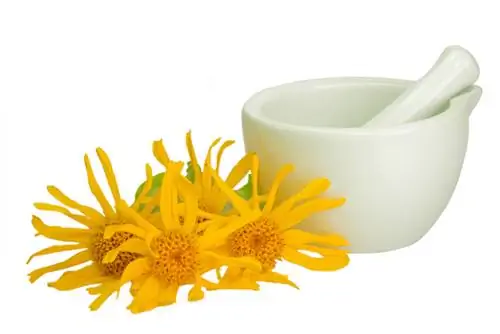- Author admin [email protected].
- Public 2023-12-26 14:17.
- Last modified 2025-06-01 06:02.
Weigelias enter the garden stage perfectly when spring bloomers wither and summer bloomers send their first buds into the race. With colorful trumpet flowers, the Asian beauties create an opulent bridge from spring to summer. The most beautiful varieties delight with re-blooming in late summer. Such an extravagant vegetation cycle requires careful pruning care. When and how to properly cut a weigela is no longer hidden from you here.

When do you cut the weigela?
Immediately after planting the weigela or at the beginning of March of the following year, the planting cut is carried out, in February in the 2nd or 3rd year the build-up cut is carried out and after the main flowering period in July the topiary cut is carried out. After the re-blooming, a care cut makes sense and a thinning cut between November and March.
Pruning care keeps Weigelia lively and blooming - cutting types with dates
In the cultivation of weigela, joy and suffering are closely linked. After just a few years of lavish blooms, the first signs of aging appear in the form of diminishing abundance of flowers. The previously tightly upright shoots bend towards the ground, so that the entire bush falls apart and loses its compact stature. At this time, a dense network of old, heavily branched and young shoots has formed inside the bush, which is only vaguely reminiscent of the opulence of the early years.
It doesn't have to come to that. Pruning care is the key to a lavish flowering period, provided it is carried out regularly and at the right time. Weigelias produce buds for the early summermain flowering period in the previous year. There-bloomingdevelops on thethis year's short shoots, which arise from the perennial wood. Although it appears so, the shrubs are not blooming on this year's long and ground shoots. If you pay special attention to idiosyncratic growth, you can't go wrong. The following table summarizes all types of cuts with information about the best date for you:
| Cut style | Goal/Occasion | best date | alternative date |
|---|---|---|---|
| Plant cutting | dense branching at the base | immediately after planting | February/March of the following year |
| Build-up cut | cultivate a stable shrub structure | February in the 2nd and 3rd year | none |
| Topiary | Maintain flowering, promote rebloom | after the main flowering period in July | February/March |
| care cut | Prevent self-seeding, maintain a well-groomed appearance | following the rebloom | none |
| Blending cut | Remove dead wood and unfavorable shoots, continuous rejuvenation | from the 4th year in late winter to the beginning of March | none |
| Rejuvenation cut | revitalizing aging weigela | between November and the end of February | none |
| Pruning when changing location | Compensation for lost root mass | between November and February |
The list of cutting types does not imply that all cutting types are necessarily suitable for your weigela. The following instructions for thinning cuts contain targeted measures for continuous rejuvenation. If you follow this recommendation, you will effectively prevent premature aging so that a rejuvenation cut is not necessary. If you want to self-sow in the bed or if you don't feel bothered by individual shoots sticking out of the shape, you can also skip the late summer care pruning without replacement.
Planting pruning - this is how you get the branching going
Cost-conscious home gardeners purchase weigelia as bare-root products or choose container products at the cheapest price range. In the best case, the young plants have three main shoots with a length of 60 to 100 centimeters. Gardeners who are familiar with the effects of plant pruning are not irritated by the poor appearance. With this cut you get the branching going:
- Best date is after planting in autumn
- Alternatively, do the plant cutting by the end of February
- Cut all shoots back by half, as shown in the picture below
- Ideally cut a few millimeters above a pair of buds or leaf nodes
- Cut off damaged roots on bare-root young bushes
There is no doubt that pruning weigelia is at the expense of the first flowering period. In return, lively branching occurs at the base of the bush with a long-term effect. The reward for doing without is a bushy flowering bush that lasts into old weigela age.

Your weigela will branch vigorously if you cut back all shoots by half after planting. Cut off damaged root tips from a bare-rooted young bush.
Background
Pruning takes advantage of the law of growth
Are you wondering why the reaction of a weigela to the plant cut can be predicted so reliably? The forecast is based on the knowledge that sap pressure regulates growth. Like all plants, the weigela also strives unerringly in the direction of the light. In order to reach the goal as quickly as possible, it pumps the majority of its reserve substances into the top buds. The process can be recognized by the fact that the bush grows disproportionately at the highest point. Since this growth behavior is common in the plant kingdom, botanists have developed the growth law of peak promotion from it. By removing the top buds of the young shoots during the planting cut, deeper buds benefit from the excess sap flow and sprout vigorously.
It blooms splendidly on the stable scaffolding - construction pruning instructions
Weigelias naturally develop a framework of strong ground shoots that remain vital and blooming for up to seven years. For a variety of reasons, it makes sense to limit the number of scaffold shoots. For a compact habitus in a small garden, as part of a mixed hedge or in a pot, the following cut has proven itself in practice:
- The best time is in February of the second and third year
- Select the strongest 7 to 12 ground shoots
- Cut off remaining ground shoots at the base
Since the transition to shape and maintenance pruning is fluid, if necessary, supplement pruning care in the build-up phase in the summer. If you cut off the withered flower clusters, many varieties will bloom again in autumn.
Topiary cutting clears the way for re-blooming
Weigelias finish their main flowering between the end of June and mid-July, close to St. John's Day. If you use scissors in this phase, you pave the way for decorative re-blooming and shape the bush. In addition, you promote vital shoots of young branches, which will bear numerous flowers next year. How to cut correctly:
- The best date is close to St. John's Day (June 24th) at the latest at the end of the first flowering period
- Before pruning begins, check the bush for nesting birds
- If necessary, postpone the appointment until the breeding business is finished
- Cut off wilted flowers until the next he althy pair of leaves is found
- Short shoots that are too long in the area of this year's growth by a maximum of a third
As the illustration below shows, summer pruning care focuses on the outer areas of the bush so that a weigela maintains its well-groomed appearance.
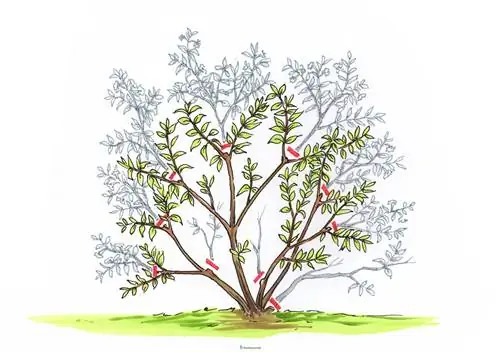
After the main flowering, cut back all dead branches down to a short, this year's branch on the perennial scaffolding shoot. Postpone the thinning of dead and unfavorable branches until late winter.
Please limit summer topiary to thede-flowered branchesand this year's growth that is too long. In numerous pruning instructions, additional thinning and continuous rejuvenation are integrated into summer pruning. Out of consideration for nesting birds, radical interventions in growth should be avoided. Native bird species such as bullfinches and blackbirds prefer to furnish their nursery with dense weigela foliage. In late winter, the Far Eastern ornamental tree copes better with thinning than in the middle of the growing season.
Background
Radical cuts on trees are only permitted in winter
Dense foliage, countless flowers and the resulting fruits not only make the weigela a sought-after nesting place for birds. Extensive pruning measures, such as thinning out dead wood or placing it on the stick, are taboo in summer. The Federal Nature Conservation Act protects our bird world and sets strict regulations. Light maintenance pruning is permitted from March 1st to September 30th, provided there are no nesting sites within the bushes. The legislature allows radical cuts from October 1st to February 28th, provided that no wild animals are disturbed.
Care cut - beneficial in two ways
Following the summer maintenance pruning, numerous weigela varieties surprise with beautiful re-blooming in late summer. If you clean out the withered flowers promptly, the tree will not invest valuable energy in the growth of seeds. At this opportunity, cheeky shoots can be cut back into the bush shape. Amoderate care cut at the end of the season is therefore beneficial in two ways. How to do it professionally:
- Cut off wilted flowers above the next pair of leaves
- Cut back individual shoots that protrude from the bush shape to just above a pair of leaves or eyes
When making the cut, take into account that your weigela has alreadybuds for next year's flowering. Limit the cutting to the withered flowers and individual, awkwardly positioned shoot tips. In the natural garden, the gardener refrains from cleaning out withered flowers so that feathered garden inhabitants can feast on the berries.
Thinning cut focuses on continuous rejuvenation
At the beginning of the third or fourth year, the vitality of scaffolding shoots decreases. At the same time, dead or unfavorably positioned branches accumulate in the bush. Reason enough to thin out the weigela. Ideally, the starting signal forcontinuous rejuvenation is given at the same time, which prevents premature aging. How to do it right:
- Best time is in February
- Tighten out dead shoots at the base
- Cutting out criss-cross, inward-facing or stunted branches
- Cut off the weaker ones from branches that are too close together
- Cut off the two oldest scaffold shoots at ground level
To maintain the scaffold structure, select the two strongest ground shoots to replace the thinned scaffold shoots. By cutting back by a third or half, you initiate vital branching on the young wood, similar to the planting cut in the first year. All other ground shoots must give way. As the illustration below demonstrates, in later years when thinning out, you should finally focus on the aged shoot tips. Affected branches are directed to an unbranched side shoot positioned further down.
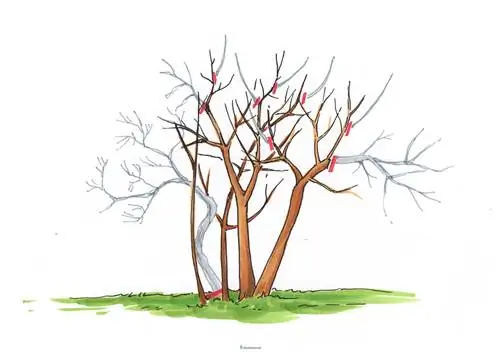
A weigela remains vital and blooming if you continually remove the two oldest scaffold shoots from the third or fourth year onwards in exchange for young ground shoots. Aging shoot tips can be rejuvenated with a derivation cut.
Background
Lead cutting - the simple and effective cutting technique
A common symptom of premature senescence on ground shoots is a broom-like shoot tip that bends to the ground under its weight. If several scaffold shoots are affected, the bush falls apart and reveals a bright center. If you cut off the broom heads, gaps will appear that will only slowly close. A derivation incision acts as a local rejuvenation and leaves no holes in the appearance. The cutting technique is incredibly simple. Examine the affected ground shoot for a young side shoot further down. Where both shoots fork, cut off the unwanted wood 5 to 8 millimeters behind the branch. From now on, the young side shoot takes over the dominant position without the cutting measure being visible.
Rejuvenation cut eliminates cutting errors
Without continuous rejuvenation in conjunction with pruning, your weigela will only be a shadow of its former self after a few years. That is no reason to clear the picturesque flowering bush. Since the Asian ornamental trees sprout from old wood, a radical cut promises the prospect of a new one. How to put an old weigela on the stick:
- The best time is on a frost-free day between the end of November and the end of February
- Cut off dead scaffold shoots at the base first
- Saw off remaining, over-aged ground shoots to 5 to 10 centimeters
- Fertilize the root disc with 3 liters of compost and 100 grams of horn shavings
If ground shoots were not pruned to 5 to 10 centimeters in previous years, unsightly heads with tightly intertwined whorls of branches often form, as shown in the figure below. You can correct the cutting error step by step. The first step is to cut off all shoots just above the head. Only in the following year do you cut off the stump at the base. At the same time, you promote young ground shoots in order to build a new framework.

If scaffolding shoots are simply cut somewhere, heads with dense branch whorls form with no prospect of valuable flower wood. Here only a rejuvenation cut can turn back the wheel of time. Proceed in stages by cutting off the old whorls in the first winter and removing the heads at ground level in the second winter.
Excursus
Special cutting tool takes on branch whorls
Gardeners are well equipped with one-handed pruning shears for the initial pruning care of weigelia. The decision between bypass and anvil mechanics is subject to individual requirements. Choosing the right tool becomes more difficult when you need to thin out an old, densely branched weigela. The tangled whorls of branches are a headache, as they hardly offer any starting points for the cut, even for Japanese saws. As a problem solver, the focus is on a special two-handed shrub shear with a rotating cutting head that can handle branches up to 4 centimeters in diameter. The handles are spread out far from the cutting head, making it possible to maneuver in the thickest branches. With a purchase price of around 100 euros, the ARS pruning shears are available from specialist retailers.
Raising Weigela as a standard tree - this is how it works
Magnificent weigela standard stems from specialist retailers are usually crowns grafted onto a trunk and have their price. Cutting tolerance and growth behavior also make it possible to train a young plant from scratch to become a shapely standard tree. A weigela with a strong, 60 to 150 centimeter long central shoot is equipped with the best conditions. How to master the parenting experience with flying colors:
- Tie the center shoot to a support rod with soft hose ties
- Cut off competing ground shoots at the base
- Remove side branches arising from the central shoot
- In parallel with the height growth, guide the central shoot up the rod
Once the central shoot has reached the desired trunk height, initiate crown formation. To do this, count four to five eyes from the desired crown height towards the top of the shoot. If you cut off the shoot tip just above the fifth eye, the branching will begin. Assign the task of leading branches to the five strongest shoots. All other side shoots along the trunk are removed.
Attentive readers of this tutorial will not have missed the fact that the growth law of top support is once again important for the successful upbringing of high-stem children. As long as the top bud is perched on the middle shoot, you can rely on rapid height growth. At the same time as the top buds are removed, the excess sap pressure flows into deeper buds and crown branching begins. Only cut off the top when you are completely sure that no further growth is desired. Subsequent trunk extension is rarely successful.
Special use for the scissors - transplanting old weigela
Weigelias are the ideal ornamental trees for gardeners who like to redesign their green realm. The bushes tolerate a change of location even at an advanced age. The most important prerequisites are the right time and a strong pruning. This is how pruning supports rooting after transplanting:
- Best time is between November and February
- Before transplanting, cut back all shoots by half
- Then dig up the weigela and plant it in the new location
There is no question that you have to forego the first flowering period after pruning. In connection with a change of location, so much root mass is lost that your weigela would lack the strength to develop flowers anyway. Pruning restores balance between above-ground and below-ground growth.
Frequently asked questions
Is a weigela bush poisonous?
The breathtakingly beautiful trumpet flowers of a weigela are perfect for the family garden. No part of the plant contains toxic ingredients. This applies equally to flowers, leaves and berries. If a small child curiously snacks on the flowers or fruits, there is no risk of he alth problems. Due to the disgusting taste, it's a one-time tasting anyway. Therefore, no special precautions need to be taken for gardening maintenance work.
I intend to incorporate weigela 'Bristol Ruby' into a mixed hedge. How should the planting distance be measured so that an opaque hedge is formed? Can I keep the weigela slimmer by cutting measures than the normal width of 150 to 200 centimeters?
If the weigela serves as part of a mixed hedge, a planting distance of 100 centimeters is considered appropriate. The plant's excellent tolerance to cutting means that the width can easily be limited to a slim 100 centimeters. The recommended date for topiary cutting is after flowering, ideally close to St. John's Day, June 24th. Ideally, you should do the hedge thinning in late winter.
Can I still trim my weigela 'Bristol Ruby' at the beginning of March? If so, what should you pay attention to when cutting?
The best time to prune weigelia is after the flowering period. Alternatively, you can cut back the flowering bush in early spring. This choice of date is of course accompanied by the loss of this year's flowers. Weigelias lay their buds the previous year. Only a small re-bloom appears on this year's wood. If you prune at the beginning of March, thin out the oldest shoots so that young, flowering wood can form. If the shrub grows too tall, it tends to have thin, bare growth. Cut back branches that are too long by half to encourage strong branching.
My dwarf weiglie 'Purpurrea' is in a pot on the terrace. When and how much can I cut the bush?
It is up to you to decide how much you want to cut back the length of the shoots. Ideally, combine pruning with the simultaneous removal of dead branches. The best time is after the flowering period. In principle, it is possible to care for a dwarf weigela throughout the summer. An appointment in spring until March 1st or autumn from October 1st is at the expense of the abundance of flowers and is primarily reserved for thinning out dead wood or a rejuvenation cut.
The 3 most common cutting mistakes
When gardeners struggle with a sparse, bald, flowerless weigela, they have fallen victim to a pruning error. So that you are prepared for oversights in pruning care, the following table draws attention to the 3 most common mishaps:
| Cutting errors | malicious image | Prevention |
|---|---|---|
| Shoots cut back in spring | Cancellation of this year's flowering season | Topiary always after flowering, thin out in February |
| old scaffold shoots sawn off at knee height | Formation of thick heads with dense, flowerless branch whorls | Plane scaffold shoots level with the ground |
| no pruning carried out | bare, sparsely branched growth in the lower part of the bush | cut all shoots back by half after planting |

Tip
An organic nutrient supply completes the pruning care of weigela. Pamper the beauty of flowers in March and June with ripe compost and horn shavings. Rake in the fertilizer carefully so as not to injure the shallow-rooted plant. Pour generously. A potassium-rich fertilizer in autumn, such as comfrey manure or Thomaskali, is beneficial for winter hardiness.

